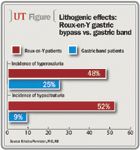Article
Stone risk varies with two bariatric procedures
Author(s):
Laparoscopic gastric band placement confers a lower lithogenic risk than the Roux-en-Y gastric bypass.
Madison, WI-Laparoscopic gastric band (LGB) placement confers a lower lithogenic risk than the Roux-en-Y gastric bypass (RYGB), which is consistent with the different mechanisms of these bariatric procedures, according to recently published research.
Researchers from the University of Wisconsin, Madison, reviewed results from 24-hour urine collections performed in 27 patients who had undergone RYGB and 12 who had undergone LGB placement. Mean time since bariatric surgery was 3.4 years in the RYGB group and about 2 years in the LGB patients.

In a similar study, researchers from Johns Hopkins University, Baltimore found that gastric banding was not associated with an increased risk for stone disease (Urology 2009; 74:746-9).
"The RYGB procedure causes significant GI malabsorption that results in hyperoxaluria, and several papers have reported it is associated with an increased risk of kidney stones and a high prevalence of calcium oxalate deposits in the inner medullary collecting ducts," said first author Kristina Penniston, PhD, RD, an associate scientist at the University of Wisconsin, working with Stephen Y. Nakada, MD, and colleagues. "LGB is a restrictive procedure and does not cause malabsorption.
"While [urolithiasis risk] appears lower than after malabsorptive procedures, LGB also appears to result in low urine volume. Therefore, a recommendation to increase fluid intake to promote a more dilute, less saturated urine seems appropriate for all patients who have bariatric surgery."
Focusing on the RYGB patients, Dr. Penniston reported that in half of those with hyperoxaluria, the 24-hour urinary oxalate excretion exceeded 60 mg/day. The problems with hyperoxaluria occurred despite use of calcium supplements, and urinary oxalate did not correlate with pre- or postoperative weight or BMI.
"Hyperoxaluria after RYGB does not seem to dissipate with time and was at a level that may be considered nephrotoxic in an appreciable proportion of patients. The findings in this group raise a question of how much calcium supplementation is needed, and it may be that an extremely high intake is required in some malabsorptive patients," she said.















